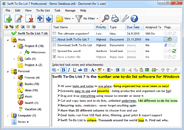Effectively prioritizing is a very important skill to master in order to work efficiently. One of our customers, Gary, has been curious how I personally do this with Swift To-Do List. I’m going to share some techniques that I use myself in this post.
Next tasks
Next tasks are tasks that you are currently working on. You should always know what tasks to currently work on. At any given moment, you should be able to easily pull a list of these “next tasks”.
There are two main approaches that work well for me personally:
1. The “Next” priority: I’ve created a new priority called “Next”, and I’ve set it a bright green color. Now I always assign this priority to tasks that I want to complete today or in the next couple of days. I usually have around 5-20 tasks with this “Next” priority.
The downside is that these tasks are in various to-do lists, so I need to use the “View All To-Do Lists” view mode to view all tasks. Then, I either sort the tasks by priority to see what’s next, or use filter to display just the tasks with the “Next” priority.
2. The “Next” To-Do List: This is an alternative approach. In this case, I create a new to-do list called “Next”, and I drag & drop tasks that I want to work on now into it. The rest of my to-do lists act as a database (or library) of tasks that I pick tasks from.
The downside is that the tasks moved to the “Next” To-Do List will lose their original to-do list categorization. However, the upside is that it is ridiculously easy to display the list of next tasks, and I can also reorder the tasks in the list. Also, I usually delete the completed tasks anyway, so the loss of the original to-do list categorization is no big deal for me.
Next actions
Every of your tasks has a certain sub-tasks (or steps, or actions, however you call it). GTD (Getting Things Done) uses the term “Next action”.
It is very important to know the next step necessary for completion of any of the tasks you are currently working on.
Task notes are usually the most efficient way of recording the next actions. Simply write mini to-do list into the notes of the task you are currently working on. You can be very specific and write lots of details and thoughts. Once you complete any step, simply delete it from the task notes.
Since Swift To-Do List 9, you can create subtasks. You can now have the next steps in form of sub-tasks directly in the task-view. This is probably the most powerful approach.
Prioritizing in fast-paced environment
The above techniques of managing next tasks and next actions work pretty well in majority of cases. However, there is one exception.
Some complex tasks (eg. software development) are in constant shift, and you can complete literally over 50 small steps (sub-tasks) every day while working on such major task or project.
In such cases, I simply create a new memo for any complex task that I am currently working on. The large text area works great for “chaotic” and complex tasks that require a lot of thinking and are changing constantly. Memos give me a great deal of freedom and flexibility in these cases.
How about you?
Please don’t hesitate to share your own approach to prioritizing in the comments below.
Related Posts:





